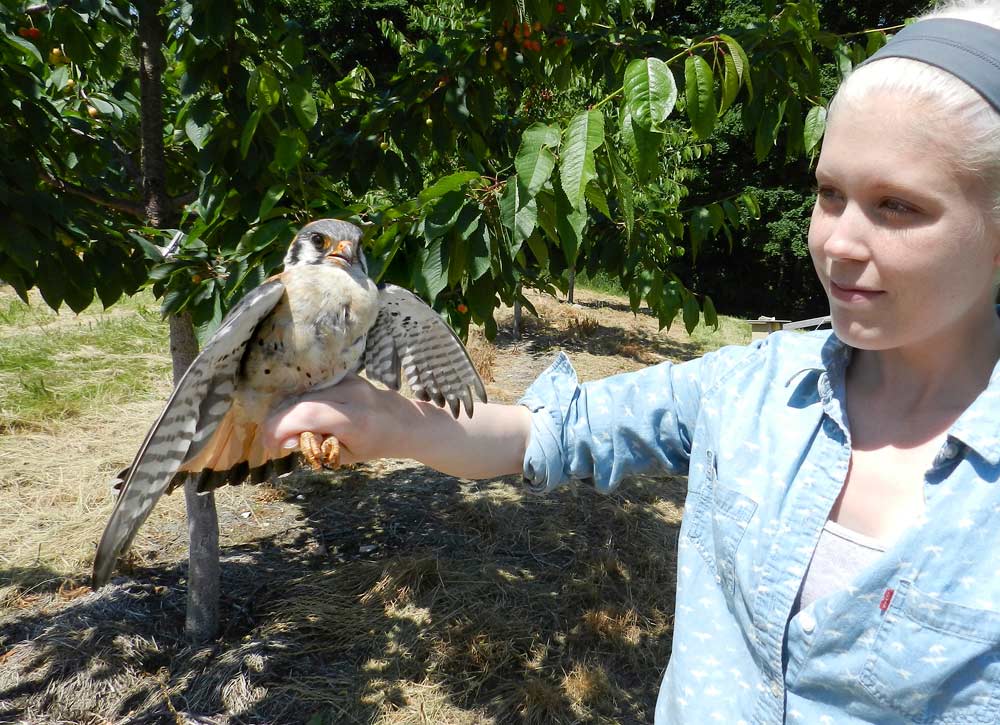
The American kestrel, held by Michigan State University researcher Megan Shave, is a small falcon common across North America. This falcon is under study as a possible deterrent to fruit-eating birds. (Courtesy Catherine Lindell)
With their vibrant rust-colored backs, blue-gray wings and black-speckled breasts, American kestrels are handsome birds that are native to much of North America. These robin-sized falcons are also skilled predators that attack and deter all kinds of farm pests, including the throng of European starlings and other small birds that descend on fruits every summer.
Over the past seven years, researchers at Michigan State University have been studying kestrels with a focus on whether cherry and blueberry growers, in particular, can use nest boxes to recruit the predators and possibly reduce bird damage to their crops.
The nest boxes do indeed deter pest birds in cherry orchards, said researcher Megan Shave, a graduate student in the lab of Catherine Lindell of Michigan State University’s Integrative Biology Department.
She and Lindell conducted their work as part of a wide-ranging investigation of strategies to decrease bird-caused damage, funded with a four-year, $2 million grant from the U.S. Department of Agriculture Specialty Crops Research Initiative as well as a subsequent three-year, $500,000 grant from the National Science Foundation’s Coupled Natural Human Systems program.
For the study, they installed 25 new nest boxes in cherry orchards in the summer of 2012, then monitored them during the breeding season from 2013 to 2016.
“We found that the kestrels responded very quickly to the installation of the boxes, and not only has every box been occupied at least once in the four years, but most have also been occupied every single year they have been up,” Shave said. Of occupied nests, 90 to 91 percent produced young.
In addition, results showed that the number of fruit-eating birds was significantly lower in cherry orchards with an active kestrel nest box and that the resulting reduction in fruit damage and increase in fruit production easily made up for the low cost of a nest box (around $10 in materials) and minimal labor involved (initial installation followed by once-a-year cleaning). Detailed results will be published later this year.

An American kestrel nest box is installed in a blueberry field with the help of graduate students Shave, and Melissa Brady, center, and Michigan State University associate professor Catherine Lindell. (Courtesy Amanda LaFay)
Because kestrels have large territories, Shave noted that just one nest box every half mile is enough to have an effect. Growers also should not use rodenticides when kestrels are present, she said.
“That wasn’t a problem in our study area where kestrels are migratory and only present in the summer when growers typically don’t have rodent problems, but it could be an issue in different areas of the country where the kestrel population is present year-round.”
Lindell and another graduate student have now begun a similar study in blueberry fields to see how the nest boxes perform there. Preliminary data indicates the nest boxes attract kestrels, but perhaps not quite as well as do boxes in cherry orchards, Shave said. That research is continuing.
Based on the cherry study, Shave said she hopes that growers will consider adding kestrel nest boxes for several reasons, including an increased harvest and a potential reduction in the need for chemicals to deter fruit-eating birds.
Beyond that, nest boxes also contribute to the conservation of kestrels, which have experienced an enormous drop of 50 percent in numbers since the mid-1960s.
“What I’d like to highlight is not that nest boxes are a silver bullet that is going to completely eliminate pest problems, but that it is a tool that we think farmers should keep in as part of their integrated pest management,” she said. “Plus, they’re just a nice thing that farmers can do for our native kestrels.” •
—by Leslie Mertz






Leave A Comment